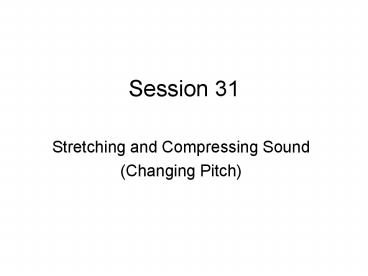Stretching and Compressing Sound - PowerPoint PPT Presentation
1 / 13
Title:
Stretching and Compressing Sound
Description:
We will take Exam #2 next Friday (April 13th) It will cover material through chapter 10. ... get through half a cycle in the same time we used to get ... – PowerPoint PPT presentation
Number of Views:84
Avg rating:3.0/5.0
Title: Stretching and Compressing Sound
1
Session 31
- Stretching and Compressing Sound
- (Changing Pitch)
2
Quick Announcements
- This is all we are going to do with Sound. There
are more things we could look at, but we need to
move on. - We will take Exam 2 next Friday (April 13th)
- It will cover material through chapter 10.
3
Changing the Sound Frequency
- The frequency of a wave is the number of cycles
per second (cps), or Hertz (Hz) - (Complex sounds have more than one frequency in
them.) - Our perception of pitch is related
(logarithmically) to changes in frequency - Higher frequencies are perceived as higher
pitches - We can hear between 5 Hz and 20,000 Hz (20 kHz)
- A above middle C is 440 Hz
4
Double the Frequency
- If we take every other sample we double the
frequency of the sound - Completes two cycles instead of one in the same
time - It will sound higher
100 200 300 400 500
100 300 500 0 0
5
Double Frequency Method
- public void doubleFreq()
- // make a copy of the original sound
- Sound s new Sound(this.getFileName())
- / loop and increment target index
- by one but source index by 2,
- and set target value
- to the copy of the original sound
- /
6
Double Frequency - Continued
- for (int sourceIndex0, targetIndex 0
- sourceIndex
- sourceIndexsourceIndex2,
targetIndex) - this.setSampleValueAt(targetIndex,
- s.getSampleValueAt(sou
rceIndex)) - // clear out the rest of this sound to
silence (0) - for (int i this.getLength() / 2
- i
- i)
- this.setSampleValueAt(i,0)
7
Test Double Frequency
- Sound s new Sound(FileChooser.getMediaPath(
- "c4.wav"))
- s.explore()
- s.doubleFreq()
- s.explore()
8
Halving the Frequency
- We can copy each source value twice to half the
frequency - Only get through half a cycle in the same time we
used to get through a full cycle - It will sound lower
- This is the same algorithm that we used to scale
up a picture
100 200 300 400 500
100 100 200 200 300
9
Halve Frequency Method
- public void halveFreq()
- // make a copy of the original sound
- Sound s new Sound(this.getFileName())
- / loop through the sound and increment
target index - by one but source index by 0.5 and set
target value - to the copy of the original sound
- /
- for (double sourceIndex0, targetIndex 0
- targetIndex
- sourceIndexsourceIndex0.5,
targetIndex) - this.setSampleValueAt((int) targetIndex,
- s.getSampleValueAt((int)
sourceIndex))
10
Testing Halve Frequency
- Sound s new Sound(FileChooser.getMediaPath(
- "c4.wav"))
- s.explore()
- s.halveFreq()
- s.explore()
11
Generalizing this
- //Program 86
- public void changeFreq2(double factor)
- Sound s new Sound(this.getFileName())
- for (double sourceIndex0, targetIndex 0
- targetIndex
- sourceIndexsourceIndexfactor,
targetIndex) - if (sourceIndex s.getLength() )
- sourceIndex 0
- this.setsampleValueAt((int) targetIndex,
- s.getSampleValueAt((int) sourceIndex))
12
What the heck does that do?
13
My changeFrequency method
- /Note, this is VERY different from that shown
in your book - _at_param init The samplingRate of the
original file - _at_param mod The samplingRate of the modified
file - /
- public Sound changeFrequency(int init, int mod)
- Sound output new Sound( (int)
(this.getLength() mod/init) ) - for (int i0i
- int replacethis.getSampleValueAt( (int) (
i init/mod ) ) - output.setSampleValueAt( i , replace)
- return output































